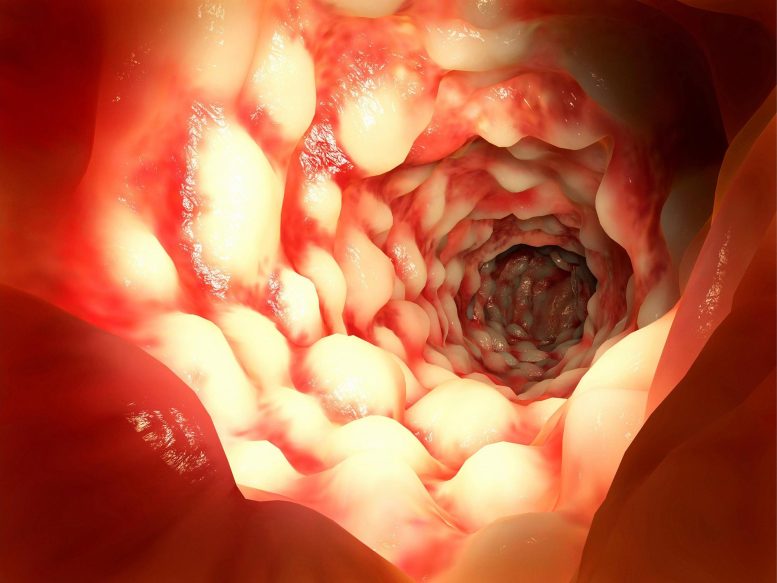
According to new research, environmental chemicals increase the risk of inflammatory bowel disease.
Using multiple research platforms, including a machine learning approach, researchers have identified environmental factors that promote gastrointestinal inflammation.
A study by Brigham and Women’s Hospital identified a herbicide, propyzamide, as a potential environmental contributor to Inflammatory Bowel Disease (IBD) by disrupting a key anti-inflammatory pathway. This discovery paves the way for new anti-inflammatory drugs and strategies to limit exposure to such chemicals.
Inflammatory bowel disease (IBD), a condition that is becoming increasingly common in industrialized countries, is characterized by chronic gastrointestinal inflammation. While investigators have identified roughly 200 genetic tags associated with the disease, there is a limited understanding of the specific environmental factors that influence the risk and severity of IBD.
A new study leverages multiple research platforms to systematically identify environmental chemical agents that influence gastrointestinal inflammation. The findings identify a common herbicide, propyzamide, that may promote inflammation in the small and large intestines. Conducted by scientists from Brigham and Women’s Hospital, a founding member of the Mass General Brigham healthcare system, the study will be published today (October 19) in the journal Nature.
Inflammatory Bowel Disease (IBD) is a general term that describes conditions characterized by chronic inflammation of the gastrointestinal (GI) tract. Crohn’s disease and ulcerative colitis are the two most prevalent inflammatory bowel diseases.
“Environmental factors are known to be just as important as genetic factors in influencing autoimmune and inflammatory disease, yet we lack a method or platform to systematically identify the effect of chemical candidates on inflammation,” said Francisco Quintana, PhD, corresponding author of the study. He is an investigator in the Brigham’s Ann Romney Center for Neurologic Diseases, whose lab has previously investigated environmental determinants of neurodegeneration. “Our methodology allowed us to identify a chemical that disrupts one of the body’s natural ‘brakes’ on inflammation. This method can identify new chemical candidates for epidemiological studies, as well as novel mechanisms that regulate autoimmune responses. In addition, this platform can also be used to screen and design for therapeutic anti-inflammatory drugs.
The investigators conducted their work by integrating IBD genetics databases with a large Environmental Protection Agency database, ToxCast, which includes biochemical data on consumer, industrial, and agricultural products. They identified chemicals predicted to modulate inflammatory pathways and then used a novel zebrafish IBD model to test these compounds and determine whether they improve, worsen, or did not affect gut inflammation. Next, the researchers used a machine learning algorithm trained on the studied compounds to identify additional chemicals in the ToxCast database likely to promote inflammation. Out of the top 20 candidates, 11 of which are used in agriculture, the researchers chose to further examine propyzamide, which is commonly applied to sports fields and fruit and vegetable crops to control weeds.
In subsequent cell-culture, zebrafish, and mouse studies, the researchers demonstrated that propyzamide interferes with the aryl hydrocarbon receptor (AHR), a transcription factor that Quintana first reported in 2008 to be involved in immune regulation. In this study, the researchers found that AHR maintains gut homeostasis by suppressing a second, pro-inflammatory pathway (the NF-κB-C/EBPβ-driven response). C/EBPβ was previously demonstrated to be genetically linked with IBD, but this study outlines the specific mechanism by which the genetic biomarker leads to increased intestinal inflammation.
The researchers are currently working to engineer nanoparticles and probiotics that can target the inflammatory pathway they have identified. Notably, the U.S. Food and Drug Administration recently approved a topical cream for psoriasis, called tapinarof, which functions by activating the anti-inflammatory AHR pathway, raising the possibility that a similar drug for IBD may be able to be developed by taking advantage of this mechanism. The activation of the AHR pathway may also be relevant for the treatment of other autoimmune diseases like multiple sclerosis and type 1 diabetes, which are mediated by similar immune cells (T-cells) driven by the pro-inflammatory NF-κB-C/EBPβ response.
“The anti-inflammatory AHR pathway we identified could be strengthened to ameliorate disease, and, further down the road, we could also investigate additional ways to deactivate the pro-inflammatory NF-κB-C/EBPβ response,” Quintana said. “As we learn more about the environmental factors that might contribute to disease, we can develop state- and national-level strategies to limit exposures. Some chemicals don’t seem to be toxic when tested under basic conditions, but we do not yet know about the effect of chronic, low-level exposures over decades, or early on in development.”
Reference: “Identification of environmental factors that promote intestinal inflammation” by Liliana M. Sanmarco, Chun-Cheih Chao, Yu-Chao Wang, Jessica E. Kenison, Zhaorong Li, Joseph M. Rone, Claudia M. Rejano-Gordillo, Carolina M. Polonio, Cristina Gutierrez-Vazquez, Gavin Piester, Agustin Plasencia, Lucinda Li, Federico Giovannoni, Hong-Gyun Lee, Camilo Faust Akl, Michael A. Wheeler, Ivan Mascanfroni, Merja Jaronen, Moneera Alsuwailm, Patrick Hewson, Ada Yeste, Brian M. Andersen, Diana G. Franks, Chien-Jung Huang, Millicent Ekwudo, Emily C. Tjon, Veit Rothhammer, Maisa Takenaka, Kalil Alves de Lima, Mathias Linnerbauer, Lydia Guo, Ruxandra Covacu, Hugo Queva, Pedro Henrique Fonseca-Castro, Maha Al Bladi, Laura M. Cox, Kevin J. Hodgetts, Mark E. Hahn, Alexander Mildner, Joshua Korzenik, Russ Hauser, Scott B. Snapper and Francisco J. Quintana, 19 October 2022, Nature.
DOI: 10.1038/s41586-022-05308-6
Funding: This work was supported by the National Institutes of Health (NS087867, ES025530, ES032323, AI126880, and AI093903).









Before any “magical” is invented change your diet. My wife and both daughters have IBS… the wife & oldest became Vegetarian. The youngest no.If you’re not committed to make a full change, understandable. Try one day a week, give it thr full day then work you’re way up. If you never increase to more than one day it’s better than nothing. Like smoking & drinking. You didn’t get where your are over night.